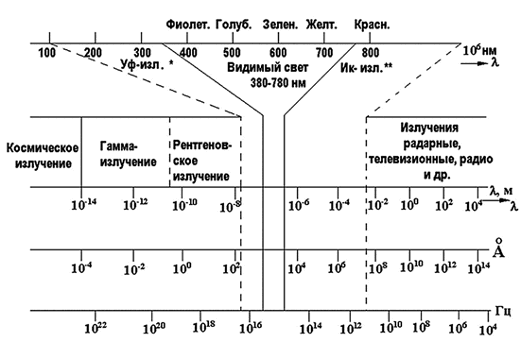
Hardware for verifying the authenticity of documents based on the optical method of non-destructive testing.
KEKIN Aleksey Gennadievich,
KOVALEV Aleksey Alekseevich,
KOVALEV Dmitry Alekseevich,
STUDITSKY Aleksandr Sergeevich,
FEDOTOV Aleksey Vladimirovich,
KHNYKOV Yury Alekseevich
The problem of determining the authenticity of documents arose simultaneously with their appearance.
As for counterfeiters, they have always been there.
Even when mankind did not yet know money, exchanging goods for pieces of gold, shells, cocoa beans, etc., individual “craftsmen” managed to find a cheaper replacement for this surrogate money.
Nothing has changed fundamentally since then. Only the technologies for issuing documents and banknotes, and consequently counterfeits, have become more complex.
Determining the authenticity of documents, banknotes and securities is part of the tasks of forensic diagnostics.
The objects of forensic diagnostics are written documents, the study of which primarily concerns their requisites (records, seal and stamp impressions, typewritten texts, notes, etc.);
the materials from which they are made (paper, paints, glues, etc.);
traces left by writing instruments and other devices (seals, stamps, printing machines, etc.);
residues of etching agents used to remove text, etc.
Documents include:
- personal (identification documents – passports, driver’s licenses, diplomas, etc.), work books characterizing work activity, sick leave certificates, references, personal files, etc.);
- reference and identification documents (certificates of education, presence of children, salary, place of work, etc.);
- monetary (checkbooks, receipt and expenditure orders, cash books, payrolls, banknotes, etc.);
- reflecting the movement of material assets (invoices, accounting journals, waybills, etc.);
- other (lottery tickets, cash tickets, train and airline tickets, prescriptions, cash receipts, etc.).
The tasks that constitute the subject of forensic diagnostics are usually divided into two groups: diagnostic and identification.
The following can be attributed to the tasks of diagnostic research:
- establishing the method of production of the document and its parts;
- establishing the fact and method of making changes to a document or part thereof;
- determining the type and kind of document;
- establishing the original content of the document (identifying invisible and poorly visible texts, faded, filled in, crossed out, smeared, etched, cleaned-up entries, texts on burnt documents, texts on indented strokes, etc.);
- determining the age of the document and the sequence of execution of its requisites.
Determining the authenticity of a document, seal, or stamp is a difficult task, but only a technically equipped specialist or expert can do it.
The objectives of identification research are as follows:
- determining whether the compared objects (documents, their materials) belong to the same genus, species, or group;
- whether the compared objects belong to the same or different sources of origin;
- the same or different materials or technical means were used to produce the document or compared documents (including the same or different printing forms were used to make impressions on the document, the texts of the document as a whole or in part were printed on the same or different typewriters, etc.);
- compilation of the whole document from its parts.
When producing a specific type of document, security systems are developed to ensure the document's resistance to unauthorized reproduction (partial or complete forgery). The security system allows you to determine the authenticity of the document at various stages of verification.
The choice of security system depends on the type of document being produced.
By type, security is divided into:
- technological;
- graphic;
- chemical;
- physical;
- combined.
In turn, each of the specified types combines a specific group of methods.
Technological type combines methods based on the calculation of specific properties of the created object.
Such methods may include:
- calculated paper composition;
- specified composition of coloring agents;
- surface treatment of paper web;
- watermark;
- specified composition in paper mass of colored and luminescent fibers or other confetti inclusions;
- a given combination of protective inclusions;
- polygraphic relief printing;
- Kipp effect, characterizing the nature of intaglio printing, recognizable under special lighting.
The graphic appearance of protection predetermines a set of methods based on the use of forms, dimensional characteristics, techniques for the arrangement and combination of elements of a graphic image as protection.
In this case, the graphic image may be both visible and invisible under normal lighting and visualized in ultraviolet (UV) and infrared (IR) rays.
These security methods may include:
- pseudo-watermark;
- guilloche frames;
- guilloche rosettes;
- microtext;
- protective grids;
- irregular raster;
- assure, corro;
- fonts of various shapes and combinations;
- combined rasterization;
- a combination of protective grids of various shapes and types;
- specially brought out at the micro level defects of graphic elements;
- pseudo-fibers;
- asymmetrical arrangement of the graphic image.
The chemical type of protection of forms of securities unites methods of protection, the essence of which is based on the properties of chemical substances to enter into chemical reactions with other compounds with the ability to control the result:
- color reaction method.
Physical type protection includes protection methods based on the physical properties of objects and substances.
Methods of this type are varied and can be determined by the following:
- changing the shape of the surface of the elements of the security form (embossed printing);
- marking elements with holograms and metograms;
- enhancing or quenching the luminescence of the surface of the security form;
- luminescence of substances with different quantum yields;
- a combination of luminescent substances with different color ranges;
- glow of substances in IR, UV and SES rays;
- use of substances with different magnetic properties.
A combined type of protection is the use of different types of protection in combination:
- using the method of plastic deformation of the surface of the object in combination with an image (embossed printing + guilloche rosette);
- with the introduction of luminescent substances into the coloring matter of grids, guilloche frames, rosettes, etc.;
- with chemiluminescence.
This classification shows how wide is the range of types and methods used in the development, production and verification of documents for authenticity.
For many types of documents, for example, identity documents — passports, driver's licenses — the introduction of laminating layers with special properties is typical.
The known part of the information about the elements of document security is confidential and is not published through open channels.
Hardware means of document control allow to identify the listed signs of document authenticity and characteristic signs of partial or complete forgery.
Complete forgery of a document, which achieves complete similarity with the original, requires the criminal, in addition to a certain skill, to have the necessary materials, fonts, similar printing devices, etc.
Because of this, forgery of documents produced at a printing company using modern technology and the implementation of certain means of protection appears to be a rather complex task for the noted category of persons.
For this reason, complete counterfeiting of document forms, performed with the reproduction of the entire security system, is extremely rare. More common are cases of reproduction of forms that imitate the original form to one degree or another.
The main most frequently imitated elements (means) of protection of document forms are a watermark, a security strip, fibers, and elements of printing security.
Partial counterfeiting consists of making individual changes to the original document.
Such changes are made by:
- erasures;
- chemical etching of text;
- additions, additional printing, corrections to the text;
- replacement of parts of a document (photographs, sheets in multi-page documents);
- forgery of signatures, seals and stamps.
Document control hardware also allows for the restoration of images accidentally or intentionally hidden under ink fills or under glued sheets of documents.
It is known that the financial and credit system has consistently held the lead in our country in terms of crime rates.
Crimes using fictitious bank guarantees, counterfeit bills, letters of credit, etc. are taking the lead.
The scale of the use of counterfeit documents recorded by law enforcement agencies confirms the effectiveness of the criminal community's use of modern technologies and computing tools.
The availability of such equipment as a computer with standard software, a laser or inkjet printer, a photocopier or a risograph significantly simplifies the possibility of falsifying documents.
The same is true for seals and stamps intended for documents that grant their owners special powers.
The production of counterfeit seals is currently widespread. The technology for making cliches is so simple that their production can be organized in any kitchen.
The authenticity of a document is established exclusively by conducting forensic studies in the process of its identification.
This type of research is always conducted by comparing the document being examined with the original.
The following algorithm for conducting research exists:
- visual inspection of the document in diffuse daylight;
- determination of geometric dimensions, presence and location of graphic design elements;
- examination of a document by transmission;
- examination of a document in oblique light;
- study of a document using a microscope, a source of ultraviolet radiation, an infrared visualizer, a device for magneto-optical control (in certain cases, laser technology and electron microscopy may be used);
- if the document has chemical protection, then at the last stage, since this occurs in most cases with a violation of the document itself or part of it, chemical studies are carried out;
- First of all, a study of the document is carried out to identify the set of protections introduced into it during production and release into operation.
In the process of studying an object, differences are mainly sought, not similarities.
Special attention is required to the problem of circulation and detection of counterfeit Russian banknotes and currency, which is currently mostly represented on the Russian market by American dollars and euros.
It should not be assumed that the problem of counterfeit money has only just hit Russia. For example, in the early 80s of the last century, a huge number of counterfeit chervonets were circulating in the USSR, continuing to participate in trade turnover on an equal basis with real money right up to the point of monetary exchange.
As for American dollars, in all likelihood, no one knows exactly how many counterfeit banknotes are in circulation.
Any currency has several levels of protection.
1. The simplest, visible to the naked eye: watermarks, relief printing, etc.
2. More complex, detected by equipment: magnetic, ultraviolet, infrared, etc.
3. Special — known only to specialist developers and manufacturers, is a state secret.
Russian banknotes are currently among the most secure banknotes. As for American dollars, until 1990 their security was based mainly on high-quality printing, paper composition and dyes used.
In 1996, the dollar acquired a new design. It featured security threads, microtext, and since 2000, additional infrared protection.
The most common method of making counterfeit money today is crude counterfeiting.
Color printers or copy machines are used to produce banknotes. The banknotes are of obviously poor quality and are intended for sale at night or in specially created situations.
The second type of counterfeit banknotes, produced using printing equipment and computer technology in mini-printing houses, is of average quality. Such products have some security features, such as microtext, as well as crude counterfeiting of ultraviolet and infrared protection.
Finally, super counterfeits.
During their production, the technological process is reproduced, including the printing method, paper composition, security elements, watermarks, etc.
Such products are made at the state level. Experts claim that the bulk of super-counterfeits come from the Middle East.
Special optical-electronic video comparator systems allow an effective solution to the problem of identifying counterfeits and fakes.
Video comparator systems belong to the class of search technical means based on introscopy and non-destructive testing methods and are intended for diagnostics of the surface of dielectric materials.
The basis of the method is optical control in reflected and transmitted radiation of a fixed range of a wide spectrum of electromagnetic radiation.
Video comparator systems are a powerful diagnostic tool in forensic science, providing, through the registration of luminescence of organic and bioorganic substances and materials, the solution of problems of forensic medical examination, analysis of the authenticity of works of art, determination of the reliability of securities, banknotes and documents, detection and registration of hidden fingerprints and microquantities of bioorganic compounds.
Figure 1 schematically shows the spectrum of electromagnetic radiation, where the zone corresponding to the optical control method is highlighted.
This zone includes UV, visible and IR radiation.
Fig. 1. Electromagnetic radiation spectrum:
1. UV radiation, defined as optical radiation with wavelengths shorter than that of visible light, which is divided into three groups:
— UV-A (long waves) – 315 – 400 nm;
— UV-B (medium waves) – 280 – 315 nm;
— UV-C (short waves) – 100 – 280 nm
2. Visible light – electromagnetic radiation with wavelengths from 400 to 760 nm
3. IR radiation is optical radiation with wavelengths longer than visible radiation, which is divided into three groups:
— IR-A (short waves) – 800 – 1400 nm;
— IR-B (medium waves) – 1400 – 3000 nm;
— IR-C (long waves) – 3000 – 10000 nm
Table 1 provides a list of the main tasks solved using a specific type of radiation.
In addition to the traditional UV range of the luminescence excitation spectrum, the use of highly efficient blue (470 nm) and green (525 nm) light sources ensures high optical contrasts in the luminescence of flavins.
The radiation range from yellow-green (560 nm) and yellow (590 nm) to red (640 nm) allows for the detection of inscriptions, seals and stamps destroyed by chemical etching, the restoration of the image of seals or primary inscriptions covered with ink or ink, the identification of additions and corrections to texts, and in some cases the assessment of the age of their writing.
Table 1.
|
UV radiation |
Intense visible radiation (blue-green or laser) |
Infrared radiation |
||
|
254 nm |
365 nm |
|||
|
Fluorescence in the visible range of optical radiation |
IR luminescence |
Anti-Stokes radiation |
Variations in the absorption and reflection of IR radiation (certain wavelengths). |
|
| Detection of fluorescent cryptography. Detection of erasures. Detection of fluorescent fibers in paper. Detection of latent images or latent inscriptions made with fluorescent inks (paints). Detection of grease stains, residual microquantities of blood, sperm and other organic substances. Checking screen fluorescence. |
Differentiation of various inks and mastics (determining the difference between visually identical inks. Detection and restoration of etched inscriptions and stamps. Detection of additions, corrections, erasures and erasures. Detection of latent images and inscriptions. Detection of fingerprints. |
Detection of the presence of special marking substances on the surface of dielectric materials and in liquids. Verification of the authenticity of banknotes, excise and special stamps. | Detection of primary inscriptions and images filled with ink or mascara. Visualization of erased texts. Detection of deliberate changes. Detection of the fact of erasures, additions or corrections made with different inks. Deciphering charred or ancient documents. Determining the fact of seals and stamps being placed with various mastics. Detecting counterfeit signatures. Determining the presence of residual amounts of gunpowder, explosives, lead, etc. (traces of a shot). |
|
It should be noted that modern video comparative systems include a highly sensitive wide-range television channel with a set of filters of various types, as well as, as a rule, a computer, which increases the sensitivity and reliability of control by reducing the intensity of background luminescence and processing the results of visual information.
In addition to comparative stationary systems, in practice, much simpler, wearable, portable devices are used, allowing you to quickly solve a specific problem of control or verification of the authenticity of documents.
The range of such devices is quite wide and includes ultraviolet emitters of different ranges and different designs, IR visualizers, combined systems placed in cases, which in their capabilities are close to simple comparators, so-called “forensic units” designed to equip passport control points, currency exchange points, cash desks, etc.
The priority purpose of such equipment is to check a wide variety of documents with various design methods in conditions of mass flow. This determines the choice of visual observation of the document being examined, both direct and with the help of television channels or image brightness amplifiers.
The devices are designed mainly for use by personnel who do not have special training.
The devices use an optimal combination of document sheet illumination methods, including upper UV, visible and IR with an observable response in backscattered and luminescent visible and IR radiation, lateral visible and IR radiation with a response in scattered radiation, lower visible and IR illumination with observation in the same ranges.
The set of tools also includes portable powerful IR illuminators with a specially selected wavelength for exciting visible anti-Stokes luminescence of special protective IR dyes.
Below are illustrations of the capabilities of control in the optical range of the spectrum, obtained on samples of equipment created at the NIIIN MNPO «Spectrum».
Control of fragments of a document sheet luminescent in visible radiation under the influence of initiating UV radiation, as indicated above, ensures the detection of protective marks of luminescent dyes.
UV radiation also allows for the detection of signs of counterfeiting and unauthorized impacts, such as:
— substitution of paper grade;
— falsified watermarks;
— traces of re-gluing of design elements using residual fragments of glue;
— traces of exposure to washing and etching agents.
Photo 1 illustrates the glow of the protective mark of the luminescent dye, indicating the authenticity of the passport.
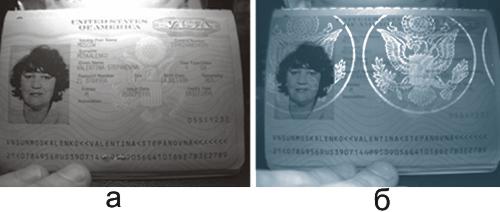
Photo 1. Image of a passport page in visible (a) and UV (b) radiation
As a rule, rather complex images of security marks cannot be reproduced accurately enough when counterfeiting. Practice shows that with basic skills of the inspector, the main features of such marks allow one to differentiate differences in design quite clearly and send samples suspected of counterfeiting for in-depth examination by an expert.
Photo 2 shows an example of a crude counterfeit of a $100 US banknote and a genuine banknote of the same denomination.
On the back of the counterfeit banknote, an intense blue glow of bleach luminescence excited by UV radiation is clearly visible, indicating that ordinary writing paper was used to make the counterfeit.
On the front of the counterfeit banknote, a counterfeit watermark is clearly visible in reflected radiation, which is not visually visible on the original under the same UV lighting conditions.
The presence of such signs is, in principle, sufficient for a reliable judgment about forgery by an inspector who does not have special training, without the need for further in-depth hardware verification.

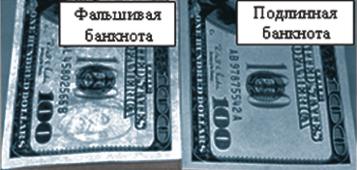
Photo 2. Images of the back and front sides of samples of genuine and counterfeit US $100 banknotes under UV illumination
Reflected IR radiation allows you to control such signs of authenticity as the presence and quality of watermarks, the presence and distribution of metameric and other special dyes across the document field.
The method allows detecting additions made with single-color writing materials (ink, ballpoint, capillary and gel pen pastes) with different levels of IR absorption, optically dense elements of document design under IR-transparent dye fills, including on the back of the sheet and the next sheet.
Photo 3 shows television images of the distribution of metameric dye and watermarks on a genuine Russian 100-ruble banknote, obtained in reflected IR radiation, as an illustration.
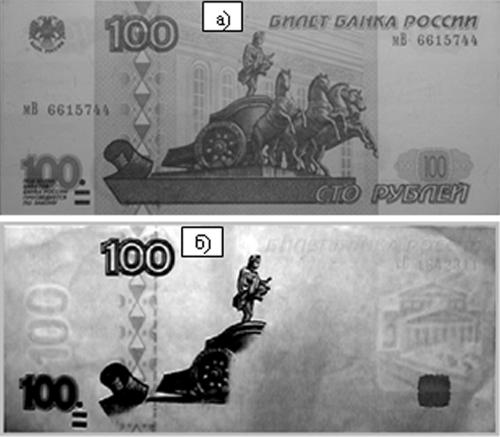
Photo 3. Image of a Russian 100-ruble banknote in
visible (a)
and reflected IR radiation (b)
Photo 3 clearly shows the distribution of the metameric pair of dyes, which provide the same visual impression in visible radiation, but have different absorption in the short-wave range of IR radiation, which is a sign of the authenticity of the banknote. In addition, high-quality images of watermarks are clearly recorded, allowing us to judge their structure.
It should be noted that by varying the spectral range of the initiating IR radiation, additional signs of authenticity of a number of large Russian banknotes, not given in this work, are detected by equipment, allowing us to check the typographic design of the banknotes and assess their authenticity in reflected IR radiation.
Photos 4 and 5 show IR images of fragments of various sizes of sheet margins of a counterfeit (made on genuine paper and with high-quality printing details) and genuine US $100 banknote of 1996 with signs of authenticity, recorded by equipment in reflected IR radiation of different ranges.

Photo 4. Images of the front side
genuine (a)
and counterfeit (b)
US banknotes in reflected IR radiation
From photo 4 it is evident that in the IR image of the front side of the genuine banknote in the upper left corner there is a difference in the optical density of the image of the number and series of the banknote with the density of the image of the letter and numeral of the US Federal Reserve Bank that issued the banknote, which are perceived as the same in visible radiation.
At the same time, the image of the letter and number of the bank remains optically dense, and the optical density of the number and series decreases.
The test of this feature was carried out on a series of samples of genuine banknotes, where it was revealed with 100% repeatability.
In the presented sample of the counterfeit banknote, the optical density of the above-mentioned details in the IR image decreases in the same way. It should be noted that in all samples of counterfeits that were checked, the same quality of these details was observed as in the presented banknote.
From photo 5, it is clear that in the IR image of the back of the genuine banknote, two contrasting light stripes are visible, caused by the application of a metameric pair of dyes to the banknote. In the presented sample of the counterfeit banknote, the metameric pair of dyes is absent.
Additional information is provided by checking in different spectral zones of IR radiation.
As an example, we can cite the images of a fragment of the upper part of the banknote in the “transparent” for IR radiation zone shown in the figure, where you can see a change in the optical density of the inscriptions on the genuine banknote and the absence of this on the counterfeit banknote.
The shown signs of authenticity allow the inspector to judge the authenticity of the banknote with a high degree of certainty without special training.
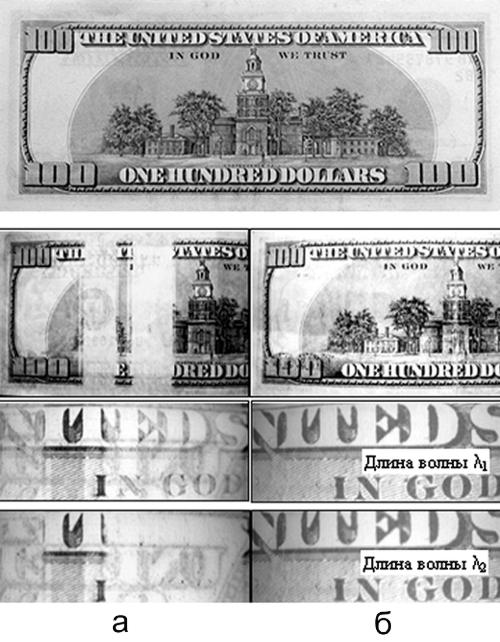
Photo 5. Images of the reverse side of the genuine (a)
and counterfeit (b)
US banknotes in reflected IR radiation
Photo 6 shows the main elements of IR protection of a 500 euro banknote as an example.
Photo 6. Images of a 500 euro banknote in visible (a) and reflected IR (b) radiation
Here are clearly expressed the features that allow one to reliably judge the authenticity of the banknote.
For example, the IR image clearly shows the presence and distribution of a metameric pair of dyes.
As with checking a dollar bill, additional information is provided by checking in different spectral zones of IR radiation.
The difference in optical densities of images of one of the typographic design details is shown in photo 7.

Wavelength l1

Wavelength l2
Photo 7. Image of a fragment of the field of a 500 euro banknote in two spectral ranges of IR radiation
Photo 8 shows the possibility of detecting an addition made with a ballpoint pen ink that is the same color as the original entry, but has less IR absorption.

Photo 8. Detection of an addition made with the same color ballpoint pen ink as the original in reflected IR radiation:
a) image in visible light;
b) image in reflected IR radiation
Photo 9, which shows a record with additions made with gel pens, illustrates the need to vary the spectral ranges of the IR radiation used when checking handwritten documents.
 |
|
|
Wavelength l1 |
Wavelength l2 |
|
Photo 9. Detection of an addition made with the same color as the original gel pen in one of two ranges of reflected IR radiation |
|
Photos 10, 11, 12 illustrate the possibility of detecting preliminary pencil drawings when forging a signature, visualizing images under fills and on the next sheet of the document glued to the back of the sheet being examined.
 |
|
|
a) image in visible light; |
b) image in reflected IR radiation |
|
Photo 10. Detection of preliminary pencil drawing in reflected IR radiation: |
|
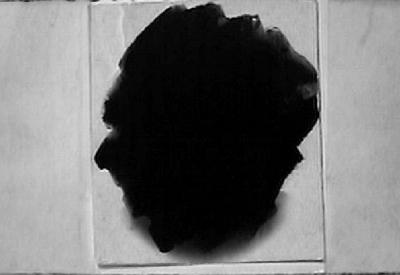
a) image in visible light;

b) image in reflected IR radiation
Photo 11. Detection of an image under ink filling in reflected IR radiation:
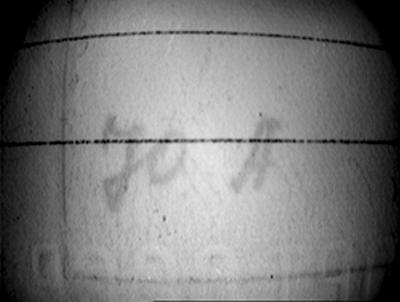
Photo 12. Detection of an image on the opposite
side of a document sheet in reflected IR radiation
IR luminescence, which occurs under the influence of initiating visible radiation, ensures the detection of marks of special dyes used in some types of documents, allows to control the presence in paper of security fibers that do not luminesce under the influence of UV radiation, as, for example, in paper used to produce US dollars (photo 13 shows IR luminescence of fibers in the paper of a genuine banknote).

Photo 13. IR luminescence of the security fibers of the paper
of a genuine US $100 banknote
The method allows identifying additions made with single-color writing materials (ink, ballpoint, capillary and gel pen paste) with different IR luminescence output, luminescent elements of document design on the back of the sheet and the next sheet.
In some cases, the method allows restoring images of washed-out or etched design elements.
An example of an addition made with the same color ballpoint pen ink as the original and revealed in IR luminescence is shown in photo 14.

a) image in visible light;
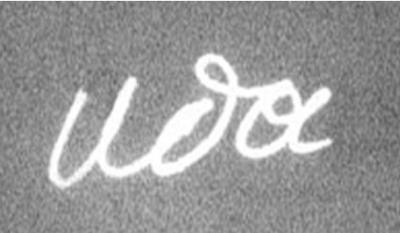
b) image of IR luminescence
Photo 14. Detection of an addition made with a ballpoint pen in the same color as the original in IR luminescence
Photo 15 illustrates the possibility of restoring
an etched stamp found on a sheet of a real document.
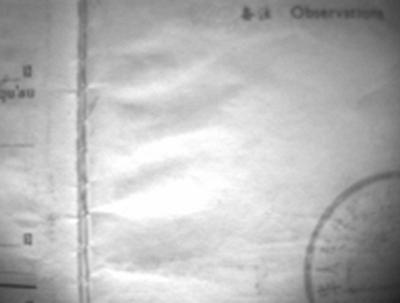
a) image in visible light;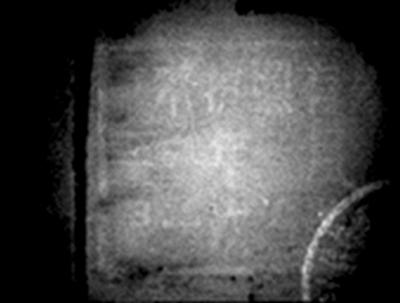
b) IR luminescence image
Photo 15. Restoration of the etched stamp image in IR luminescence
In the lateral oblique radiation, relief elements of the document design are detected under the fills and hatching.
Traces of erasures and erasures, traces of pressure from the writing instrument are detected on the relief elements.
The use of lateral IR illumination allows more reliable detection of these types of impacts in case of contamination, flooding or shading of the affected sheet area.
Examining a document against the light allows monitoring the quality of watermarks, identifying erasures, erasures by changes in the optical density of the sheet, traces of re-gluing, design elements on the back of the sheet and the next sheet.
In IR scanning in different ranges, metameric and other special IR dyes are additionally checked.
Research in transmitted and reflected IR radiation in the light can also solve individual search problems, for example, checking official mailings to detect unauthorized paper or powder attachments.
The Russian enterprise NIIIN MNPO «Spectr» has developed a wide range of equipment for these purposes based on the optical method of non-destructive testing.
The method is based on the analysis of the response signal that occurs when primary initiating radiation of the optical range interacts with substances of the object under study.
Primary radiation with wavelengths of 240 – 1100 nm is used with various illumination methods. The response signal is scattered and luminescent radiation in spectral zones from 300 nm to 1000 m.
The company produces a wide range of devices for document control, from simple portable ones to computerized systems.
The former include portable devices for control in long-wave (“Dozor”, “Korund UV”, “Grif-2M”) and short-wave (“Dozor-V”) UV radiation (photo 16), the “Korund IK” device for control in reflected IR radiation with visualization of IR images, special IR illuminators “Dozor-IKM, IKB” for detecting anti-Stokes luminescence.
These devices solve the problem of checking documents outside equipped control points.
The IR video magnifier “Genetika-3402” (photo 17) provides visual inspection in reflected and fluorescent IR radiation.
The forensic unit “Genetika-3102” (photo 18) provides inspection using a UV illuminator and sources of incident, oblique and transmitted visible radiation.
The inspection of microfragments is provided by the color image video microscope “Telemic-1”.
The KRN-2 set of these devices provides a virtually complete set of tools for promptly checking documents in the conditions of their mass flow.
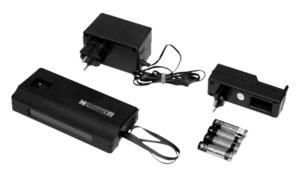
a) “Dozor”;

b) “Grif-2M”
Photo 16. Portable ultraviolet illuminators
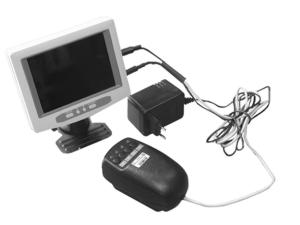
Photo 17. Infrared video magnifier “Genetics-3402”
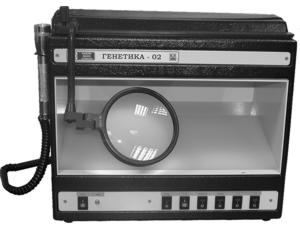
Photo 18. Forensic block “Genetics-3102”
A detailed study at a professional level is provided by the VSK-1 video spectral comparator (photo 19) with a wide-range TV camera, a number of emitters and a set of filters, allowing for in-depth studies in reflected and fluorescent radiation of the visible and IR ranges.
This device, and other devices with TV channels, have an output to a personal computer with software for in-depth processing and archiving of images.
The equipment is constantly being improved.
The mobile system “Genetika-3503” (photo 20) has been developed with means of control in UV radiation, visible incident, transmitted and oblique radiation, three-range incident, transmitted and oblique IR radiation. The system provides a virtually complete set of means for in-depth verification of documents outside equipped checkpoints.

Photo 19. Video spectral comparator VSK-1

Photo 20. Mobile system for checking documents
in non-stationary conditions “Genetika-3503”
The development of the forensic complex “Gineya-2” is being completed, in which almost all control methods and means of computer processing of primary information are implemented at a high technical level.
The given range of hardware and their functional capabilities allow to optimally satisfy the needs of any consumer whose task is to solve problems of control of documents, banknotes, securities, archival documents, material evidence, etc.
Literature
1. V.V.Klyuev, F.R.Sosnin, A.V.Kovalev et al. “Non-destructive testing and diagnostics”. 2nd edition, revised and supplemented, Moscow, “Mashinostroenie”, 2003, 656 p.
2. O.O.Shornikov. Study of documents for authenticity. “Business and security in Russia”, October 2000, pp. 58 – 59.
3. A.A.Gusev. How to recognize a counterfeit. “Private investigation, security and safety”. № 5(15), 1994, pp. 48 – 55.
4. Yu. Azman. The sour look of the currency president. Moskovsky Komsomolets, July 19, 2000.
5. A. Savin. The dollar of “gray” assembly. Izvestia, November 14, 1997.
6. A. Salnikov. Beware of counterfeits. Torgovaya Gazeta. December 5, 1997.

Добавить комментарий